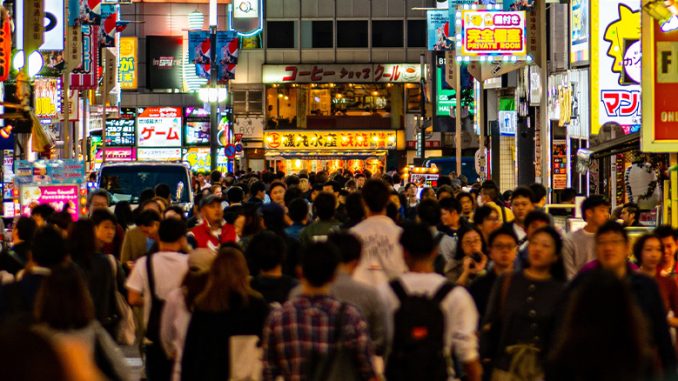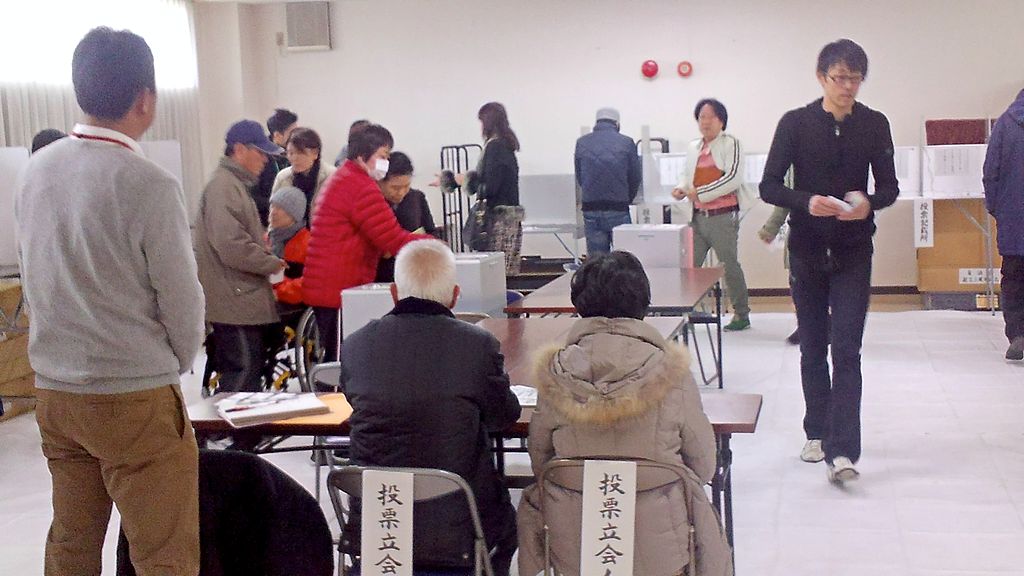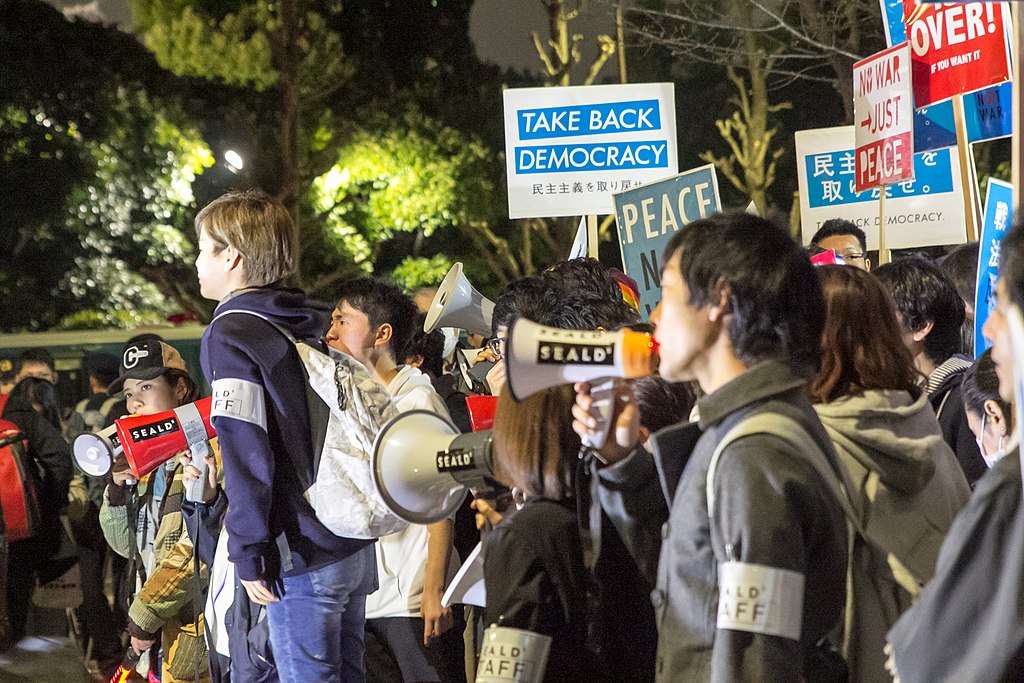
Surveys by the Japanese government show that among all ages, the usage rate of smartphone exceeded 90% in 2019, and the usage rate of LINE, the most popular social media application in Japan, exceeded 90% in 2020 (Institute for Information and Communications Policy; IICP, 2022). Nowadays, social media constitute a part of social infrastructure in Japan, by which people communicate and access various information regardless of time and place. This article discusses the role of social media in political participation in Japan, focusing on the young generation called ‘digital native’. First, the current situation of political participation among Japanese youth is discussed, followed by two cases of remarkable political actions related to social media. Lastly, challenges of political participation through social media by the young generations in Japan are examined.
Landscape of political participation by Japanese youth
Political participation by Japanese youth can be characterised by moderate level of concern and low political efficacy. First, this is shown in voter turnout, which is a common measure of political participation. In Japan, according to the official statistics by the Japanese government (Ministry of Internal Affairs and Communications; MIC, 2022), the latest voting percentage on two national elections were 52% (the Upper House; July 2022) and 56% (the Lower House; October 2021). Like other democratic countries, Japanese younger voters have been inactive on elections. The turnout among people in their twenties for the general election (the Lower House election) has been the lowest in 18 elections since 1969. The latest result was about 37%, which was approximately half the turnout of people in their sixties (71% as the highest group). In addition, although 18- and 19-year-old citizens were permitted to vote in 2016, their turnout has been the second lowest on national elections except in 2016 when they were first allowed to vote. This could be partially explained by the troublesome procedure of the certificate of residence for those who moved to another region to commute to universities (MIC, 2016), yet its impact seems to be statistically limited.

Second, Japanese young people’s attitude about political participation as the reason of constant high rates of abstention from voting seems to be reflected on international surveys. The Japanese government conducted an international survey to sample people aged from 13 to 29 in seven countries: Japan, South Korea, the United States, the United Kingdom, Germany, France, and Sweden (Cabinet Office; CAO, 2014). The results indicated that Japanese participants who were interested in domestic politics were around 50%, which is about the same as participants from other countries. Only one third of Japanese participants were satisfied with the society in their country. However, despite the unsatisfaction, only one third of Japanese participants showed political efficacy and willingness of political participation, which was the lowest among the countries.
These tendencies have been constantly observed in other international surveys of 17- to 19-year-old people in Japan and 5 or 8 other countries (Nippon Foundation, 2019; 2022). Those surveys consistently indicated that among the participating countries, Japanese youth had the most negative perspective on the future of their country and themselves, and the lowest political efficacy and willingness of political participation. This is not due to a lack of agency, as half of the Japanese participants showed interest in social and political issues, and more than half of them had a sense of agency on their life course, such as their choice of friends, partner, jobs, and so on. Such Japanese young people’s attitudes towards political conversation were characterised as “the quiet attentive – I’m interested in politics but won’t talk about it” by a qualitative study (Kligler-Vilenchik et al., 2021 597).
Social media as modern tools of political participation in Japan
Methods of political action which Japanese citizens are involved in seem to be limited compared to other countries. The latest World Values Survey (Wave Seven; Haerpfer et al., 2022) indicated that except for signing petitions offline, few Japanese people were involved in other political actions online or offline: boycott, peaceful demonstration, strike, searching information online, signing an electronic petition, encouraging other people online to take any action, and organising political activities via internet. The rates of those who answered that they have participated in the latter seven options were lower in Japan than in at least 40 out of 63 to 65 countries in the survey.
However, social media have played a certain role in some political incidents in Japan. There were remarkable political actions by Japanese citizens over the last decade, in which social media were used as platforms of protests. In 2015, university students in the Tokyo metropolitan area established a political group named ‘Student Emergency Action for Liberal Democracy’, known as ‘SEALDs’. They protested against the security policy bill which permitted the Self-Defence Force to exercise rights of collective self-defence, which they considered “unconstitutional”. They held street demonstrations many times in front of the parliament until the bill has been passed, and those activities were shared on social media, especially Twitter. While SEALDs was a symbolic group organised by students, tens of thousands of people from all age groups joined, and associated groups held demonstrations many times in several areas of Japan (Kingston, 2015).

Another example happened in 2020, known as a ‘Twitter demo’ (demonstration on Twitter) by citizens against the change of interpretation of a law and a submission of a new bill by the administration of then-Prime Minister Shinzo Abe. These controversial changes were criticised as a way to allow Hiromu Kurokawa, the then chief of the Tokyo High Public Prosecutors Office who was considered close to the Abe administration, to take over as prosecutor-general, which is the top post among public prosecutors. In other words, this was considered by critics as the administration’s violation of independence of prosecution. On May 8th at 7:40 pm, a tweet was posted by an anonymous account of a feminist female working as an advertising specialist in Tokyo, who had more than 13,000 followers then (Murakami & Yamamitsu, 2020). Under the state of emergency of COVID-19 which did not allow for street demonstrations, the tweet protesting against the attempt of the administration said “Twitter demo alone”, and its hashtag “I oppose the proposed revision of the Public Prosecutors Office Law” was shared more than 4.7 million times until the evening of May 10th (Asahi Shimbun, 2020). On May 18th, Abe announced the delay of deliberations on the bill, citing the “lack of public understanding”, and four days later, resignation of Kurokawa was approved by the Cabinet after his illegal gambling on mah-jong had been reported. Toriumi (2021) indicated that although about half of the relevant tweets were posted by only 2% of the accounts involved, the accounts of different people, including those of celebrities, joined in mentioning the issue.

Challenges of social media in political participation
As mentioned above, Twitter (now rebranded “X”) seems to have played an important role as a platform on which participants and supporters of street demonstrations were connected, and virtual demonstrations happened. The latest annual survey on social media by the Japanese government (IICP, 2022) showed that 67% of teenagers and 79% of people in their twenties were using Twitter in Japan. Therefore, Twitter would be a potential ‘field’ of political participation for Japanese youth. However, there are considerable challenges.
First, people could be exposed to opinions only from certain political positions even without realising it on social media, and this could be utilised to sway public opinion. Cambridge Analytica case is a symbolic example, in which ‘big data’ from Facebook was extracted by a British private company, Cambridge Analytica, and utilised as online ‘psychological manipulation’ for the Presidential election campaigns in the US (Kleinman, 2018). On Japanese Twitter, signs of ‘stealth propaganda’ were also reported, though the impact of them were still not concluded. Yoshida and Toriumi (2018) analysed Japanese retweets posted before and after the general election in 2017. They demonstrated that even users who did not follow any account of political parties had been exposed to information from certain political parties. Schäfer et al. (2017) followed bot activities on Japanese Twitter before and after the general election in 2014 and argued that those bot activities spread tweets supporting then-Prime Minister Shinzo Abe and criticising his critics. Such phenomena were also observed other than during national election period in Japan: Fukuma et al. (2022) demonstrated that polarisation on Twitter occurs in daily Japanese news-related topics, which could often be under the influence of noisy minority and bot activities.
Second, the division of political positions could become salient on social media including Twitter (“X”), as demonstrated by cases in other countries. Social media such as Twitter (“X”) visualise ‘online public opinions’ on political issues and enable users to send their opinions freely to other users. In a good sense, people get ‘coffeehouses’ by which they can anonymously have political conversation anywhere and anytime, but this could also strengthen people’s selective exposure and aggressive communication. Political polarisation on the internet has been pointed out since the spread of blogs (Adamic & Glance, 2005), and political ‘echo chambers’ on Twitter have been observed (e.g., Bail et al., 2018; Conover et al., 2011; Colleoni et al., 2014; Yardi & Boyd, 2010). These phenomena were also reported in Japan, as some specific topics were mentioned only within certain communities and user networks on Twitter (Takikawa & Nagayoshi, 2017).
Third, in terms of political participation, social media such as Twitter (“X”) can change the environment, but cannot necessarily change people’s attitudes. As discussed above, few Japanese people seem to take political action, and Japanese youth tend to have notably low political efficacy and low desire of political participation, which could predict their actual participation online and offline (e.g., Gil de Zúñiga et al., 2012). Twitter (“X”) use in Japan can be characterised by a prominently high rate of anonymous users. In an international survey by the Japanese government (MIC, 2014), the rate of Japanese participants using Twitter anonymously was 75%, while those rates of the participants from the other five countries (the US, the UK, France, South Korea, and Singapore) were only 31% to 45%. Also, similar tendencies were reported in the rates of those who hesitate to use their real name on social media among participants in their teens and twenties, even though those young groups were the first generation of ‘digital native’. This might reflect Japanese users’ psychological barrier to state their opinion in public.

Conclusion
The two cases discussed above imply the possibility of social media as common virtual fields where Japanese citizens get involved in political participation. Japanese youth tend to have low political efficacy and willingness of political participation while being concerned over social and political issues. However, as an article of Reuters (Murakami & Yamamitsu, 2020) described the ‘Twitter demo’ in 2020 as “rare online outrage”, tweets mentioning political issues with anger expressions tend to be posted by politically active users, while other users tend to express their anxiety (Uchida, 2018). Additionally, correlations between online and offline political participation have been observed in other countries (Leyva, 2017; Chen et al., 2016; Barberá & Rivero, 2015; Bekafigo & McBride, 2013; Vaccari et al., 2013). Therefore, social media may allow only politically active citizens in Japan to take collective actions, but do not encourage other citizens to join them, as the latest World Values Survey showed. On the other hand, some researchers also indicated that more casual political participation on social media could encourage people to join offline political actions (Vaccari et al., 2015). In any case, social media’s contribution to modern democracy in Japan needs the young generations’ active attitude and behaviour, both of which could be constructed with the changing social environment.
Atsuhiko Uchida
Banner photo: Josh Soto, Unsplash
References
Adamic, L. A., & Glance, N. (2005). The political blogosphere and the 2004 US election: divided they blog. In Proceedings of the 3rd international workshop on Link discovery (pp. 36-43).
Asahi Shimbun. (2020). 4.7 million tweets blast revision bill to delay Abe ally’s retirement. Asahi Shimbun. Retrieved from https://www.asahi.com/ajw/articles/13362865
Bail, C. A., Argyle, L. P., Brown, T. W., Bumpus, J. P., Chen, H., Hunzaker, M. F., Lee, J., Mann, M., Merhout, F., & Volfovsky, A. (2018). Exposure to opposing views on social media can increase political polarization. Proceedings of the National Academy of Sciences, 115(37), 9216-9221.
Barberá, P., & Rivero, G. (2015). Understanding the political representativeness of Twitter users. Social Science Computer Review, 33(6), 712-729.
Bekafigo, M. A., & McBride, A. (2013). Who tweets about politics? Political participation of Twitter users during the 2011gubernatorial elections. Social Science Computer Review, 31(5), 625-643.
CAO. (2014). Heisei 25 nendo Waga Kuni to Shogaikoku no Wakamono no Ishiki ni kansuru Chosa [2013 Survey on Opinions of Young People in Japan and Foreign Counties]. CAO. Retrieved from http://www8.cao.go.jp/youth/kenkyu/thinking/h25/pdf_index.html
Chen, H. T., Chan, M., & Lee, F. L. (2016). Social media use and democratic engagement: a comparative study of Hong Kong, Taiwan, and China. Chinese Journal of Communication, 9(4), 348-366.
Conover, M., Ratkiewicz, J., Francisco, M., Gonçalves, B., Menczer, F., & Flammini, A. (2011). Political polarization on twitter. Proceedings of the international aaai conference on web and social media, 5(1), 89-96.
Colleoni, E., Rozza, A., & Arvidsson, A. (2014). Echo chamber or public sphere? Predicting political orientation and measuring political homophily in Twitter using big data. Journal of communication, 64(2), 317-332.
Fukuma, T., Noda, K., Kumagai, H., Yamamoto, H., Ichikawa, Y., Kambe, K., Maubuchi, Y., & Toriumi, F. (2022). How Many Tweets DoWe Need?: Efficient Mining of Short-Term Polarized Topics on Twitter: A Case Study From Japan. arXiv preprint arXiv:2211.16305.
Gil de Zúñiga, H., Jung, N., & Valenzuela, S. (2012). Social media use for news and individuals’ social capital, civic engagement and political participation. Journal of Computer‐Mediated Communication, 17(3), 319-336.
Haerpfer, C., Inglehart, R., Moreno, A., Welzel, C., Kizilova, K., Diez-Medrano J., M. Lagos, P. Norris, E. Ponarin & B. Puranen (eds.). (2022). World Values Survey: Round Seven – Country-Pooled Datafile Version 5.0. Madrid, Spain & Vienna, Austria: JD Systems Institute & WVSA Secretariat.
IICP. (2022). Reiwa 3 nendo Johotsushin Media no Riyojikan to Johokodo nikansuru Chosa [2021 Survey on Usage Time of Information and Communication Media]. MIC. Retrieved from https://www.soumu.go.jp/iicp/research/results/media_usage-time.html
Kingston, J. (2015). SEALDs: Students Slam Abe’s Assault on Japan’s Constitution. The Asia-Pacific Journal: Japan Focus, 13 (36).
Kleinman, Z. (2018). Cambridge Analytica: The story so far. BBC. Retrieved from https://www.bbc.co.uk/news/technology-43465968
Kligler-Vilenchik, N., Tenenboim-Weinblatt, K., Boczkowski, P. J., Hayashi, K., Mitchelstein, E., & Villi, M. (2022). Youth political talk in the changing media environment: a cross-national typology. The International Journal of Press/Politics, 27(3), 589-608.
Leyva, R. (2017). Exploring UK Millennials’ Social Media Consumption Patterns and Participation in Elections, Activism, and “Slacktivism”. Social Science Computer Review, 35(4), 462-479.
MIC. (2014). ICT no Shinka ga motarasu Shakai eno Impact nikansuru Chosakenkyu [Survey on the Social Impact of the Evolution of ICT.]. MIC. Retrieved from https://www.soumu.go.jp/johotsusintokei/linkdata/h26_08_houkoku.pdf
MIC. (2016). 18 sai Senkyoken ni kansuru Ishiki Chosa Houkokusho [Opinion Poll on Suffrage of 18 Years Old Report]. MIC. Retrieved from http://www.soumu.go.jp/menu_news/s-news/01gyosei15_02000153.html
MIC. (2023). Kokusei-senkyo no Nendaibetsu Touhyouritsu no Suii nitsuite [Change on Turnout of General Elections by Age]. MIC. Retrieved from http://www.soumu.go.jp/senkyo/senkyo_s/news/sonota/nendaibetu/index.html
Murakami, S. & Yamamitsu, E. (2020). Rare online outrage in Japan forces Abe to delay controversial bill. Reuters. Retrieved from https://jp.reuters.com/article/us-japan-politics-socialmedia/rare-online-outrage-in-japan-forces-abe-to-delay-controversial-bill-idUSKBN22X0Z8
Nippon Foundation. (2019). 18 sai Ishiki Chosa “Dai 20 kai: Kuni ya Shakai nitaisuru Ishiki” (9 kakoku) [18 Years Old Opinion Survey “20th: Attitudes towards Country and Society” (9 countries)]. The Nippon Foundation. Retrieved from https://www.nippon-foundation.or.jp/what/projects/eighteen_survey
Nippon Foundation. (2022). 18 sai Ishiki Chosa “Dai 46 kai: Kuni ya Shakai nitaisuru Ishiki” (6 countries) [18 Years Old Opinion Survey “20th: Attitudes towards Country and Society” (6 countries)]. The Nippon Foundation. Retrieved from https://www.nippon-foundation.or.jp/what/projects/eighteen_survey
Schäfer, F., Evert, S., & Heinrich, P. (2017). Japan’s 2014 general election: Political bots, right-wing internet activism, and prime minister Shinzō Abe’s hidden nationalist agenda. Big data, 5(4), 294-309.
Takikawa, H., & Nagayoshi, K. (2017). Political polarization in social media: Analysis of the “Twitter political field” in Japan. In 2017 IEEE international conference on big data (big data) (pp. 3143-3150). IEEE.
Toriumi, F. (2021). Quantitative Analysis of Diffusion in Bursting Phenomena: How the Twitter Demo Spread in Japan. Japan marketing journal, 40(4), 19-32.
Uchida, A. (2018). HOW DO JAPANESE PEOPLE TALK ABOUT POLITICS ON TWITTER? ANALYSIS OF EMOTIONAL EXPRESSIONS IN POLITICAL TOPICS ON JAPANESE TWITTER. Psychologia, 61(2), 124-157.
Vaccari, C., Valeriani, A., Barberá, P., Bonneau, R., Jost, J. T., Nagler, J., & Tucker, J. (2013). Social media and political communication: a survey of Twitter users during the 2013 Italian general election. Rivista italiana di scienza politica, 43(3), 381-410.
Vaccari, C., Valeriani, A., Barberá, P., Bonneau, R., Jost, J. T., Nagler, J., & Tucker, J. A. (2015). Political expression and action on social media: Exploring the relationship between lower-and higher-threshold political activities among Twitter users in Italy. Journal of Computer-Mediated Communication, 20(2), 221-239.
Yardi, S., & Boyd, D. (2010). Dynamic debates: An analysis of group polarization over time on twitter. Bulletin of science, technology & society, 30(5), 316-327.
Yoshida, M., & Toriumi, F. (2018). Do Political Detachment Users Receive Various Political Information on Social Media?. arXiv preprint arXiv:1806.10173.
